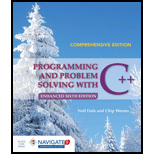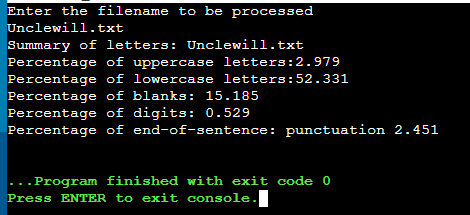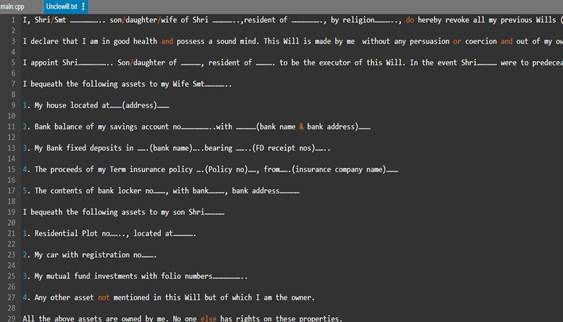
Concept explainers
Program plan:
- Declare a variable file of ifstream type to read the input from the file.
- Declare a variable letter of type char to store the letter read from the file.
- Declare 6 variables upperCounter, lowerCounter, blank, digit, punctuation, allElseCounter of type int to store the counter of each type.
- Declare a variable inFile of type String to store the name of the file read from the user.
- A do- while loop is used to read letters from the file and to increment the each type of counter.
- A switch is used to check for each type of letters and to increment the counter inside do-while loop.
Program description:
The main purpose of the program is to summarize all the contents of the file in a table with details of each type of character scanned.
Explanation of Solution
Program:
//inclusion of header files
#include <fstream>
#include <iostream>
#include <iomanip>
#include <cctype>
//using namespace
using namespace std;
//main function
int main()
{
ifstream file; //fstream input
char letter;
// Declaration and Initialization of variables
int upperCounter = 0; // counter for uppercase letters
int lowerCounter = 0; // counter for lowercase letters
int blank = 0; // counter for blanks
int digit = 0; //counter for digits
int punctuation = 0; //counter for punctuation
int allElseCounter = 0; //counter for Remaining counters
//Declare variable to store filename
string inFile;
cout<<"Enter the filename to be processed" << endl;
cin>>inFile;
//open the file
file.open(inFile.c_str());
//if file doesn’t get opened
if (!file)
{
cout<< "Filename doesn’t exist." << endl;
return 1;
}
//else read the characters
file.get(letter); // Input one letter
do
// process each letter
{
if (isupper(letter))
upperCounter++;
else if (islower(letter))
lowerCounter++;
else if (isdigit(letter))
digit++;
else
switch (letter)
{
case ' ' : blank++;
break;
case '.' :
case '?' :
case '!' : punctuation++;
break;
default : allElseCounter++;
break;
}
file.get(letter);
} while (file);
// Calculate total
float total = upperCounter + lowerCounter + blank + digit + punctuation + allElseCounter;
cout<<"Summary of letters: "<< inFile << endl;
// Letters of each type
cout<<fixed<<setprecision(3)<<"Percentage of uppercase letters:"<<upperCounter / total* 100<<endl;
cout<<fixed<<setprecision(3)<< "Percentage of lowercase letters:" << lowerCounter / total * 100 << endl;
cout<<fixed<<setprecision(3)<< "Percentage of blanks: "<< blank / total * 100 << endl;
cout<<fixed<<setprecision(3)<< "Percentage of digits: "<< digit / total * 100 << endl;
cout<<fixed<<setprecision(3)<< "Percentage of end-of-sentence: "<< "punctuation "<< punctuation / total * 100 << endl;
return 0;
}
Explanation:
In this program, first of all, the user is asked to enter the filename which needs to be processed. After entering the filename, all the characters of it are scanned to get a summary table of each type of letters. Each letter is scanned for uppercase letters, lowercase letters, for digits, blanks, and for any puctuations. Each type counter get incremented if the letter scanned is of that type. For example, if the letter scanned is of uppercase then the counter for uppercase letters will get incremented and so on. In the end, complete summary of all types of letters is printed on the screen with the filename which is scanned as shown in the output.
Output:

Contents of the file Unclewill.txt:

Want to see more full solutions like this?
Chapter 7 Solutions
Programming and Problem Solving with C++: Comprehensive
- Briefly describe the issues involved in using ATM technology in Local Area Networksarrow_forwardFor this question you will perform two levels of quicksort on an array containing these numbers: 59 41 61 73 43 57 50 13 96 88 42 77 27 95 32 89 In the first blank, enter the array contents after the top level partition. In the second blank, enter the array contents after one more partition of the left-hand subarray resulting from the first partition. In the third blank, enter the array contents after one more partition of the right-hand subarray resulting from the first partition. Print the numbers with a single space between them. Use the algorithm we covered in class, in which the first element of the subarray is the partition value. Question 1 options: Blank # 1 Blank # 2 Blank # 3arrow_forward1. Transform the E-R diagram into a set of relations. Country_of Agent ID Agent H Holds Is_Reponsible_for Consignment Number $ Value May Contain Consignment Transports Container Destination Ф R Goes Off Container Number Size Vessel Voyage Registry Vessel ID Voyage_ID Tonnagearrow_forward
- I want to solve 13.2 using matlab please helparrow_forwarda) Show a possible trace of the OSPF algorithm for computing the routing table in Router 2 forthis network.b) Show the messages used by RIP to compute routing tables.arrow_forwardusing r language to answer question 4 Question 4: Obtain a 95% standard normal bootstrap confidence interval, a 95% basic bootstrap confidence interval, and a percentile confidence interval for the ρb12 in Question 3.arrow_forward
- using r language Obtain a bootstrap t confidence interval estimate for the correlation statistic in Example 8.2 (law data in bootstrap).arrow_forwardusing r language Compute a jackknife estimate of the bias and the standard error of the correlation statistic in Example 8.2.arrow_forwardusing r languagearrow_forward
 C++ for Engineers and ScientistsComputer ScienceISBN:9781133187844Author:Bronson, Gary J.Publisher:Course Technology Ptr
C++ for Engineers and ScientistsComputer ScienceISBN:9781133187844Author:Bronson, Gary J.Publisher:Course Technology Ptr C++ Programming: From Problem Analysis to Program...Computer ScienceISBN:9781337102087Author:D. S. MalikPublisher:Cengage Learning
C++ Programming: From Problem Analysis to Program...Computer ScienceISBN:9781337102087Author:D. S. MalikPublisher:Cengage Learning Microsoft Visual C#Computer ScienceISBN:9781337102100Author:Joyce, Farrell.Publisher:Cengage Learning,
Microsoft Visual C#Computer ScienceISBN:9781337102100Author:Joyce, Farrell.Publisher:Cengage Learning, Systems ArchitectureComputer ScienceISBN:9781305080195Author:Stephen D. BurdPublisher:Cengage LearningProgramming Logic & Design ComprehensiveComputer ScienceISBN:9781337669405Author:FARRELLPublisher:Cengage
Systems ArchitectureComputer ScienceISBN:9781305080195Author:Stephen D. BurdPublisher:Cengage LearningProgramming Logic & Design ComprehensiveComputer ScienceISBN:9781337669405Author:FARRELLPublisher:Cengage Programming with Microsoft Visual Basic 2017Computer ScienceISBN:9781337102124Author:Diane ZakPublisher:Cengage Learning
Programming with Microsoft Visual Basic 2017Computer ScienceISBN:9781337102124Author:Diane ZakPublisher:Cengage Learning





